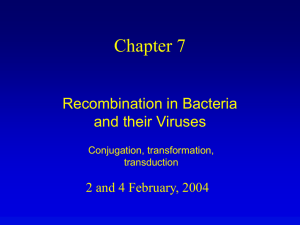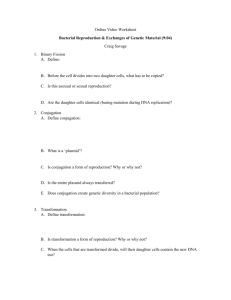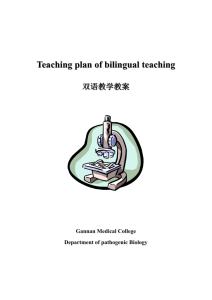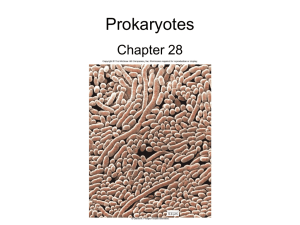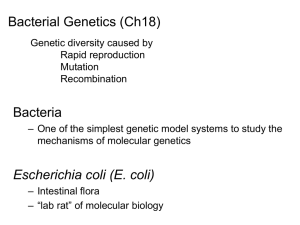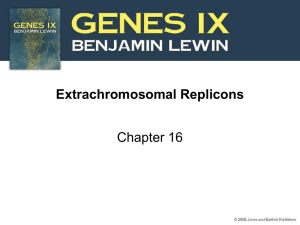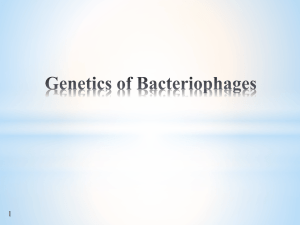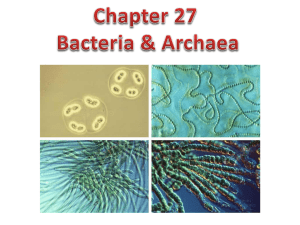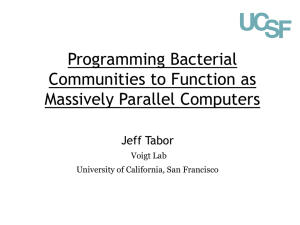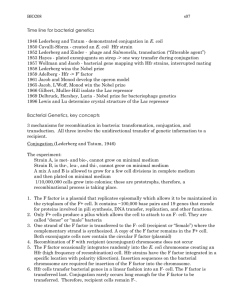Bacterial conjugation
advertisement
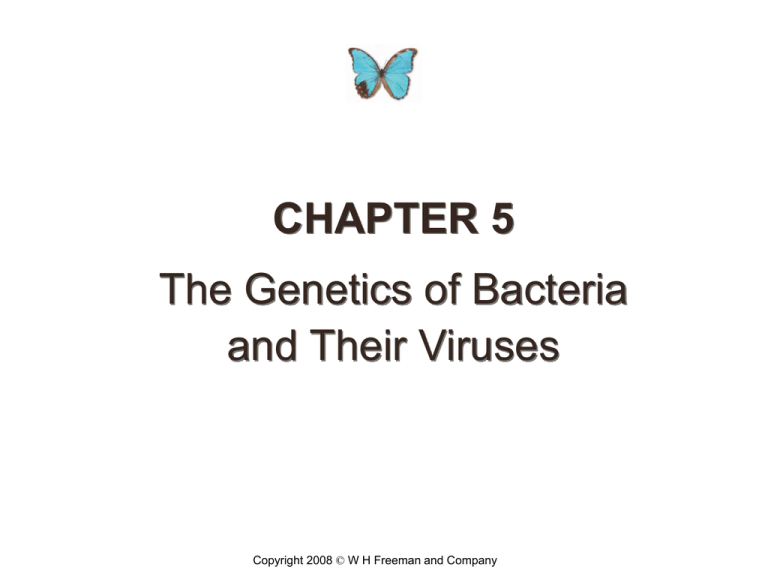
CHAPTER 5 The Genetics of Bacteria and Their Viruses Copyright 2008 © W H Freeman and Company CHAPTER OUTLINE 5.1 5.2 5.3 5.4 5.5 5.6 Working with microorganisms Bacterial conjugation Bacterial transformation Bacteriophage genetics Transduction Physical maps and linkage maps compared Working with microorganisms Dividing bacterial cells Chapter 3 Opener The fruits of DNA technology, made possible by bacterial genetics Figure 5-1 Bacteria exchange DNA by several processes Figure 5-2 Bacterial colonies, each derived from a single cell Figure 5-3 Distinguishing lac+ and lac- by using a red dye Figure 5-4 Table 5-1 Model Organism Escherichia coli Model Organism E. Coli Bacterial conjugation Mixing bacterial genotypes produces rare recombinants Figure 5-5a Mixing bacterial genotypes produces rare recombinants Figure 5-5b No recombinants are produced without cell contact Figure 5-6 Bacteria conjugate by using pili Figure 5-7 F plasmids transfer during conjugation Figure 5-8a F plasmids transfer during conjugation Figure 5-8b Integration of the F plasmid creates an Hfr strain Figure 5-9 Donor DNA is transferred as a single strand Figure 5-10 Crossovers integrate parts of the transferred donor fragment Figure 5-11 Tracking time of marker entry generates a chromosome map Figure 5-12a Tracking time of marker entry generates a chromosome map Figure 5-12b A single crossover inserts F at a specific locus, which then determines the order of gene transfer Figure 5-13 The F integration site determines the order of gene transfer in HFRs Figure 5-14 Two types of DNA transfer can take place during conjugation Figure 5-15 A single crossover cannot produce a viable recombinant Figure 5-16 The generation of various recombinants by crossing over in different regions Figure 5-17 Faulty outlooping produces F´, an F plasmid that contains chromosomal DNA Figure 5-18 Table 5-2 A plasmid with segments from many former bacterial hosts Figure 5-19 An R plasmid with resistance genes carried in a transposon Figure 5-20 Bacterial transformation Mechanism of DNA uptake by bacteria Figure 5-21 Bacteriophage genetics Structure and function of phage T4 Figure 5-22 Electron micrograph of phage T4 Figure 5-23 Electron micrograph of phage infection Figure 5-24 Cycle of a phage that lyses the host cells Figure 5-25 A plaque is a clear area in which all bacteria have been lysed by phages Figure 5-26 A phage cross made by doubly infecting the host cell with parental phages Figure 5-27 Plaques from recombinant and parental phage progeny Figure 5-28 Transduction Generalized transduction by random incorporation of bacterial DNA into phage heads Figure 5-29 From high cotransduction frequencies, close linkage is inferred Figure 5-30 Table 5-3 Transfer of prophage during conjugation can trigger lysis Figure 5-31 Transfer of prophage during conjugation can trigger lysis Figure 5-31a Transfer of prophage during conjugation can trigger lysis Figure 5-31b phage inserts by a crossover at a specific site Figure 5-32 Faulty outlooping produces phage containing bacterial DNA Figure 5-33a Faulty outlooping produces phage containing bacterial DNA Figure 5-33b Faulty outlooping produces phage containing bacterial DNA Figure 5-33c Physical maps and linkage maps compared A map of the E. coli genome obtained genetically Figure 5-34 Part of the physical map of the E. coli genome, obtained by sequencing Figure 5-35 Physical map of the E. coli genome Figure 5-36 Proportions of the genetic and physical maps are similar but not identical Figure 5-37 Transposon mutagenesis can be used to map a mutation in the genome sequence Figure 5-38
